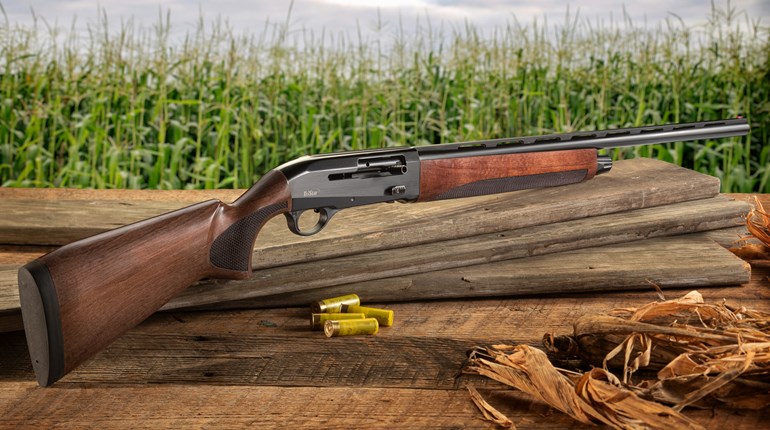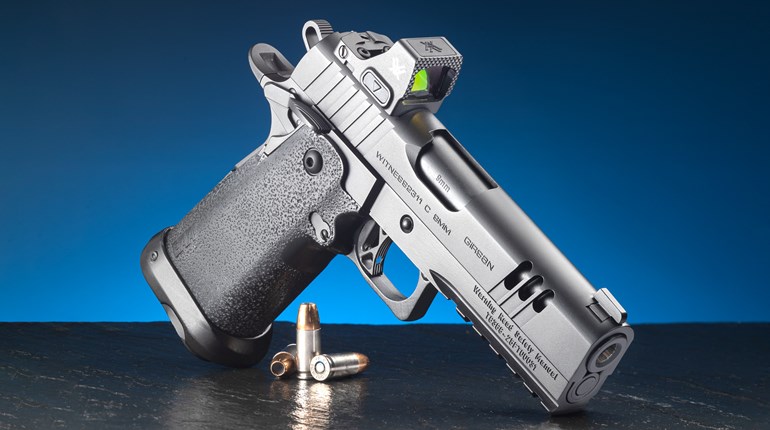
The success of the Beretta 1301 Comp shotgun led the company to release the new Pro model. Equipped with a new polymer stock and the Kick-Off Plus system, the Beretta 1301 Comp Pro semi-automatic shotgun is ready for 3-Gun competition straight out of the box.

Consisting of two elastomer dampeners with return springs that are positioned near the rubber insert, the Kick-Off Plus system effectively mitigates the first recoil peak. According to Beretta, the system reduces the perceived recoil by up to 40 percent. A third elastomer dampener, located in the stock bolt, absorbs the impact of the slide against the stock, thus reducing the second recoil peak, muzzle jump and any vibrations caused by the movement of the slide. This was noticeable while shooting the gun. It was comfortable to shoot, as well as stable and easy to swing.
The Beretta 1301 Comp Pro (MSRP: $1,675) has an overall length of 47 inches with the extended magazine tube. The length-of-pull is 14 inches, which some shooters and firearms instructors think is too long. However, this LOP seemed perfect to me. (If you have alligator arms, 14 inches may be a little long for you.) The synthetic stock has an attachment point for a sling on the bottom about four inches from the butt pad, which is unlikely to be used in the competitive shooting world. As for the synthetic forearm, it is 10.5 inches long.

The B-Steady system divides the stock into two sections—butt and forearm. Beretta says the recoil absorption point is in an advanced position, moving in unison with the forearm. This makes it free to move back, leaving the butt stable and avoiding any rubbing of the comb against the cheek. The cheek remains still and rests without ever losing the line of fire.
According to the Beretta website, for more comfort the comb comes with Soft Comb, a soft insert that is gentle against the cheek. A rubber Comfort Grip improves sensitivity and pistol grip, and provided spacers allow for drop and cast adjustment. The MicroCore recoil plate provides shouldering benefits and high stability when shooting, as well as a way to adjust the stock's length using the two spacers provided. Additionally, the ergonomic Comfort Grip fore-end, also made of polymer with a rubber insert, offers maximum grip even in poor weather conditions.

Thick and blue in color, the receiver of the Beretta 1301 Comp Pro that I tested had a rugged feel. It was drilled to have a scope mounted on the receiver if desired. The four threaded holes can also be used to add a Picatinny rail. Located on the right side of the receiver, the rectangular bolt release handle sits at the forward end. The bolt release handle is generously size, which makes hitting it simple. As for the bolt handle, it rides on the right side as well and is large and easy to grip in a hurry. Beretta says “the blue anodized Ergal stock combines lightness with extreme robustness and reliability, and inside houses the reloading system, the ultra-tested gas system with rotating head B-Link closure system, which has a 36 percent faster cycling speed than any other semi-automatic; it is reliable and accurate round after round, even with light loads.”
The safety is enlarged to the point that it is as large as a fingertip. Hitting it when picking up the shotgun is easy and nearly fumble-proof, due to its large size. If the shotgun is in the hands and the shooter has a good register position with the trigger finger, that puts the finger near the safety for smoothness when deactivating it. The Beretta 1301 safety’s location and size are well thought out. The trigger is stainless in appearance and is a solid hunk of steel. The trigger feels robust and durable to the touch, and breaks cleanly and is smooth.

The 1301 Comp Pro sports a 3-inch chamber, but uses an oversized 3.5-inch stock which facilitates cartridge loading. Another key feature is the ability to quickly load and do the quad-loads even easier. The loading gate has been enlarged and the lifter has a system which keeps it raised during loading operations, thus creating a sort of “chute” for the ammunition. This also eliminates user risk of pinching a thumb between the lever and the gate.
The Beretta website states that the ballistic performance of the 1301 Comp Pro takes full advantage of the Beretta Steelium barrel's exceptional features:
“Created using Beretta's exclusive tri-alloy steel (Ni, Cr, Mo), deep drilling, cold hammer forging, vacuum distension and characterized by the elongated 80 mm double forcing cone. The internal profile of the OptimaBore HP barrels was designed and tested to guarantee excellent ballistic performance with all types of ammunition, lead, steel and high-performance steel. The result is pattern distributions which are always dense and perfect, partly thanks to the three interchangeable OptimaChoke HP Black Edition choke tubes it is supplied with, making it possible to adjust the choke depending on the competition.”
Overall, this Beretta 1301 Comp Pro has a traditional look about it. It has a black synthetic stock and forearm rather than wood furniture, but other than that it looks like a traditional shotgun. The 1301 Comp Pro is a fine-looking gun that appears functional without being over the top in any way. The safety, bolt release and bolt racker are all located in user-friendly spots. An ergonomic gun, the 1301 Comp Pro feels great in the hands. Handling it at home in my gun room made my mouth water a bit in anticipation of shooting it.

At the Range
The range session this time around was a little unusual because Jake Martens was out of town and I was nearly on my own. I had young Royce Bright along to supervise and run the timer. The ammunition for this range session was Federal Field and Target shells. The shot size was No. 7½, 2¾ inches with 1⅛ ounces of shot. The box claims 1,200 f.p.s. at the muzzle. I opted not to fire these rounds over the chronograph because I was not confident I could do it without destroying the chronograph. These shells ran flawlessly while the gun was in my hands—not a single malfunction. They were a little light for knocking down poppers at 15 yards, but that had nothing to do with the gun.
The first drill was to do some draws. I had both hands on the gun, safety on, stock on belt and the muzzle aligned with the 15-yard target. Times were 0.99, 0.78, 0.77, 0.64 and 0.75 seconds. Hitting the safety as the gun is coming to the shoulder was no problem at all. I was trying to press the trigger as soon as the fiber-optic sight was visible. Hitting the steel USPSA target was not an issue. Better yet, I was not getting any pellets splashing back and hitting me. So far, everything was proceeding well.
The next drill was to shoot three steel USPSA targets spaced two yards apart at a distance of 15 yards (one round each). The 1301 Comp Pro was staged in a barrel with the safety on. I stood with hands below belt and directly behind the barrel. I have exactly zero 3-Gun experience, and shooting a shotgun in such a manner is new to me. My shotgun experience is mostly limited to Defensive Shotgun classes and shooting starlings and sparrows in the pasture or woods. This shooting drill was fun, and no problem for a novice shooter. Times were 2.92, 2.38, 2.39, 2.36 and 2.47 seconds (total time for the three shots). The gun came up smoothly and shouldered nicely. The length-of-pull suited me very well. Draw times on these runs were 2.20, 1.77, 1.76, 1.74 and 1.82 seconds, respectively.

The next drill was a little tougher. I added four mini-poppers to the three steel-target array, for a total of seven rounds needed to complete the shooting. Distance for all targets was 15 yards, and the width of the targets was 11 yards from left to right. The start position was shotgun in barrel with safety on, hands below belt and standing behind the gun. I shot the array from the left to the right every time. This order of engagement had me beginning on the mini poppers and finishing on the full-size targets. The times were 5.03, 4.33 and 4.56 seconds. Draw times were 2.04, 1.85 and 1.83 seconds, respectively. All targets were hit. One mini popper failed to fall on the second run, so a bonus run was completed. The bonus run was 4.68 seconds with all four poppers down. The Beretta 1301 Comp Pro was running great, the shooting was a ton of fun, and I was quickly burning through ammunition.
The next shooting test was shooting the same four-popper array, and then dumping the shotgun back into the barrel and engaging the steel USPSA targets with a handgun with two rounds each. The target array was at the same 15 yards distance and 11 yards of width. The shotgun started in the barrel with the safety on and the same starting position that had become the norm. The times were 7.90, 6.85 and 6.61 seconds. The times for the first shot with the Beretta were 2.03, 1.83 and 1.78 seconds. I was using the S&W M&P Pro in 9 mm as the handgun. All hits were accomplished with both the shotgun and handgun. Manipulating the controls on the shotgun during these shooting exercises was not a problem, because the controls are located in user-friendly locations on the gun. I re-engaged the safety as I dumped the shotgun. Even someone without any experience would have no problem making this gun run smoothly the first time on the range. This speaks to the quality of the Beretta 1301 Comp Pro and the engineering behind it.

The next shooting exercise was the Bill Drill. Start position was stock on belt, safety on and eyes looking past the muzzle at the target. Normally, Bill Drills are shot at seven yards; however, shooting steel at seven yards did not seem attractive, so I just stayed put at 15 yards. The times were 2.01, 1.94 and 1.98 seconds. The fastest first shot was 0.88 seconds on the last run; the slowest first shot was 0.93 on the first attempt. The shooter had best set their feet and lean into the gun hard, or the gauge will push you around during such shooting, even with light loads. I wish Bill Drills were as easy with a pistol.
The next drill was to shoot a steel USPSA target with three rounds and then a second target with three rounds, starting with the stock on the belt and the safety engaged. The times were 2.18, 1.92 and 2.02 seconds. The first shots were recorded as 0.88, 0.88 and 1.04 seconds. There seems to be a speed advantage starting with the gun in your hands.
The last shooting drill was standing behind a barricade with the safety on and the muzzle resting on top of the barricade. I shot from the box directly behind the barricade around the right side. I engaged the three steel targets with one round each at the 15-yard distance. My times were 2.12, 1.85 and 1.86 seconds. This shooting position was a bit more awkward than the other drills, yet the gun was comfortable to shoot. At this point, I was out of shells and so the shooting was done by default.
For me, the Beretta 1301 Comp Pro ran without a hiccup. In the spirit of full disclosure, Royce shot around a dozen rounds as well, but experienced two malfunctions. He was using the same ammunition, and the round in the chamber fired, but the gun did not cycle the next round to the chamber. I am certain that the issue was the fact he weighs only 99 pounds and he was getting pushed around by the gun. Once I told him to set his feet and lean in harder, the gun ran for him as well. (Mass is a thing—any semi-automatic gun has to have something to push against in order to run.) As mentioned before, the gun ran without flaw in my hands, even while leaning around a barricade at awkward angles.
If you are in the market for a semi-automatic shotgun for 3-gun, or even just a new fun gun, be sure to give the Beretta 1301 Comp Pro a serious look.
Learn more at beretta.com.
Article from the January/February 2021 issue of USPSA’s FrontSight magazine.
Read more: Review: Beretta 694 Sporting



































